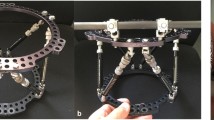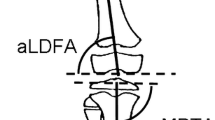Abstract
Twenty-five post-traumatic leg length discrepancies combined with axial deviation in 22 patients were treated with the Taylor spatial frame. We retrospectively analysed the accuracy of correction, the complication rate and the clinical outcome including the duration of treatment. The cases were divided into three sub-groups according to the level of the osteotomy. The mean age at operation was 22.7 years; the mean follow-up was 21.1 months. The patients presented uniplanar and multiplanar deformities in combination with leg length discrepancy. Twenty-one of 25 cases showed a frontal plane malalignment preoperatively. Only three of those 21 cases continued to show minimal malalignment postoperatively. The preoperative mechanical axis deviation present in 15 of 17 lower extremities was fully corrected in 13 extremities. The 25 lengthening and correction procedures were associated with a total of 61 difficulties, including 44 problems, seven obstacles and ten complications. In conclusion, the Taylor spatial frame allows accurate results in correction of complex post-traumatic deformities with minimal morbidity.


Similar content being viewed by others
References
Akeson WH, Amiel D, Abel MF, Garfin SR, Woo SL (1987) Effects of immobilization on joints. Clin Orthop Rel Res 219:28–37
Aronson J (1997) Current concepts review—Limb lengthening, skeletal reconstruction and bone transport with the Ilizarov method. J Bone Joint Surg Am 79(8):1243–1258
Danzinger MB, Kumar A, DeWeese J (1995) Fractures after femoral lengthening using the ilizarov method. J Pediatr Orthop 15:220–223
Docquier PL, Rodriguez D, Mousny M (2008) Three-dimensional correction of complex leg deformities using a software assisted external fixator. Acta Orthop Belg 74(6):816–822
Eidelman M, Bialik V, Katzman A (2006) Correction of deformities in children using the Taylor spatial frame. J Pediatr Orthop B 15(6):387–395
Eldridge JC, Bell DF (1991) Problems with substantial limb lengthening. Orthop Clin North Am 22:625–631
Enneking WF, Horowitz M (1972) The intra-articular effects of immobilization on the human knee. J Bone Joint Surg Am 54(5):973–985
Evans EB, Eggers GWN, Butler JK, Blumel J (1960) Experimental immobilization and remobilization of rat knee joints. J Bone Joint Surg Am 42-A:737–758
Fadel M, Hosny G (2005) The Taylor spatial frame for deformity correction in the lower limbs. Int Orthop 29:125–129
Feldman DS, Shin SS, Madan S, Koval KJ (2003) Correction of tibial malunion and nonunion with six-axis analysis deformity correction using the Taylor spatial frame. J Orthop Trauma 17(8):549–554
Fischgrund J, Paley D, Suter C (1994) Variables affecting time to bone healing during limb lengthening. Clin Orthop Relat Res 301:31–37
Herzenberg JE, Scheufele LL, Paley D, Bechtel R, Tepper S (1994) Knee range of motion in isolated femoral lengthening. Clin Orthop Relat Res 301:49–54
Hong SP, Henderson CN (1996) Articular cartilage surface changes following immobilization of the rat knee joint. A semiquantitative scanning electron-microscopic study. Acta Anat (Basel) 157(1):27–40
Ilizarov GA (1990) Clinical application of the tension-stress effect for limb lengthening. Clin Orthop Relat Res 250:8–26
Kristiansen LP, Steen H, Reikerås O (2006) No difference in tibial lengthening index by use of Taylor spatial frame or Ilizarov external fixator. Acta Orthop 77(5):772–777
Maffulli N, Nele U, Matarazzo L (2001) Changes in knee motion following femoral and tibial lengthening using the Ilizarov apparatus: a cohort study. J Orthop Sci 6(4):333–338
Manner HM, Huebl M, Radler C, Ganger R, Petje G, Grill F (2007) Accuracy of complex lower-limb deformity correction with external fixation: a comparison of the Taylor spatial frame with the Ilizarov ring fixator. J Child Orthop 1(1):55–61
Marangoz S, Feldman DS, Sala DA, Hyman JE, Vitale MG (2008) Femoral deformity correction in children and young adults using Taylor spatial frame. Clin Orthop Relat Res 466(12):3018–3024
Matsubara H, Tsuchiya H, Sakurakichi K, Watanabe K, Tomita K (2006) Deformity correction and lengthening of lower legs with an external fixator. Int Orthop 30:550–554
Nakase T, Kitano M, Kawai H, Ueda T, Higuchi C, Hamada M, Yoshikawa H (2008) Distraction osteogenesis for correction of three-dimensional deformities with shortening of lower limbs by Taylor spatial frame. Arch Orthop Trauma Surg Sep 11. [Epub ahead of print]
Naqui SZ, Thiryayi W, Foster A, Tselentakis G, Evans M, Day JB (2008) Correction of simple and complex pediatric deformities using the Taylor-Spatial Frame. J Pediatr Orthop 28(6):640–647
Paley D (1990) Problems, obstacles, and complications of limb lengthening by the Ilizarov technique. Clin Orthop Relat Res 250:81–104
Paley D, Tetsworth K (1992) Mechanical axis deviation of the lower limbs. Preoperative planning of multiapical frontal plane angular and bowing deformities of the femur and tibia. Clin Orthop Relat Res 280:65–71
Paley D, Tetsworth K (1992) Mechanical axis deviation of the lower limbs. Preoperative planning of uniapical angular deformities of the tibia or femur. Clin Orthop Relat Res 280:48–64
Tetsworth KD, Paley D (1994) Accuracy of correction of complex lower-extremity deformities by the Ilizarov method. Clin Orthop Relat Res 301:102–110
Sluga M, Pfeiffer M, Kotz R, Nehrer S (2003) Lower limb deformities in children: two-stage correction using the Taylor spatial frame. J Pediatr Orthop B 12(2):123–128
Stanitski DF, Shahcheraghi H, Nicker DA, Armstrong PF (1996) Results of tibial lengthening with the Ilizarov technique. J Pediatr Orthop 16(2):168–172
Author information
Authors and Affiliations
Corresponding author
Rights and permissions
About this article
Cite this article
Ganger, R., Radler, C., Speigner, B. et al. Correction of post-traumatic lower limb deformities using the Taylor spatial frame. International Orthopaedics (SICOT) 34, 723–730 (2010). https://doi.org/10.1007/s00264-009-0839-5
Received:
Revised:
Accepted:
Published:
Issue Date:
DOI: https://doi.org/10.1007/s00264-009-0839-5




